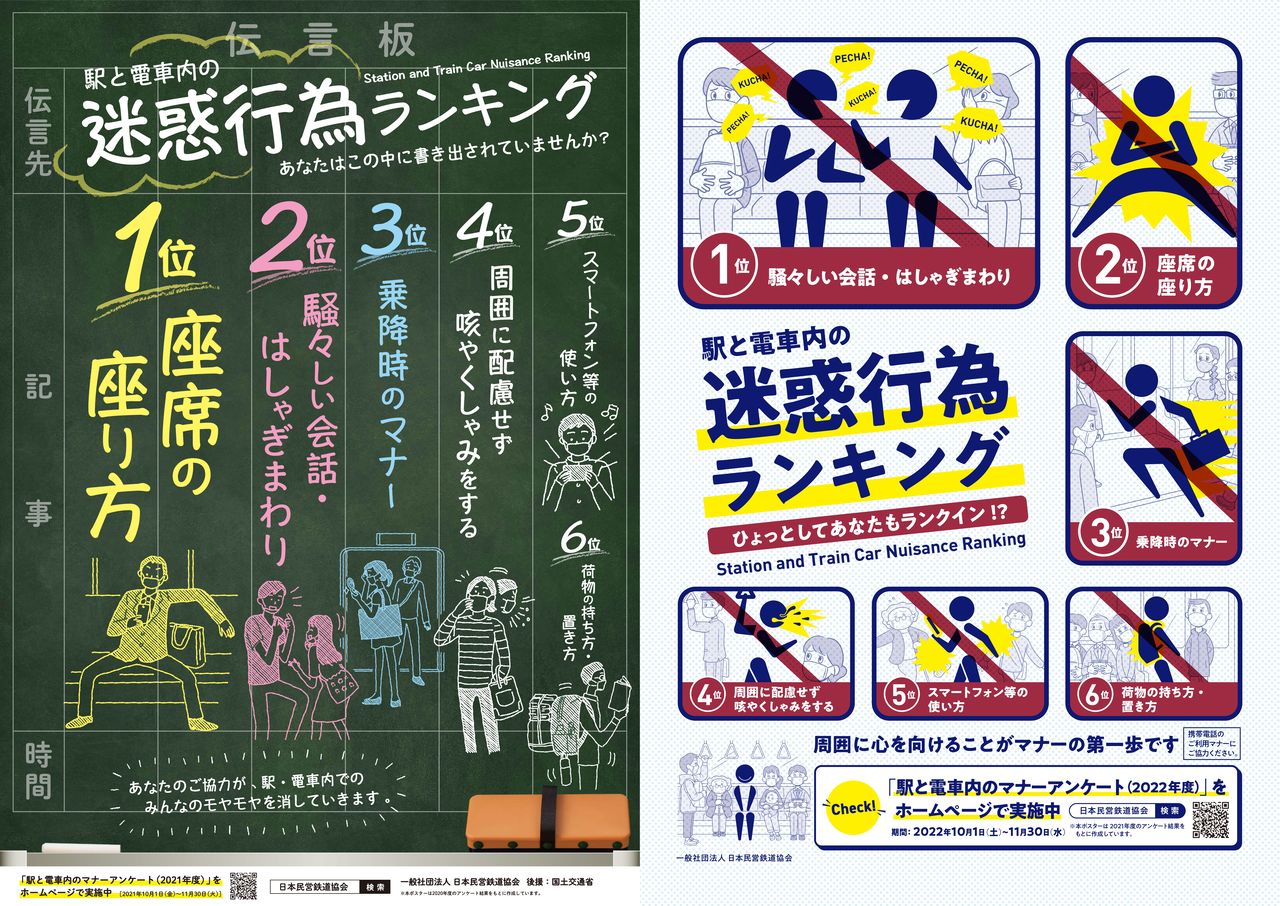
The Art of Etiquette: Japan’s Train Manners Posters
Society Lifestyle Design- English
- 日本語
- 简体字
- 繁體字
- Français
- Español
- العربية
- Русский
Japan’s Railway Manners
Good manners on Japanese trains mean sitting properly and not having loud conversations—or at least, this is what the results of a survey on annoying behavior indicate. The poll was conducted by the Japan Private Railway Association, a group of 72 private-sector rail operators across Japan.

Posters illustrating the top nuisance behavior to avoid, from fiscal 2020 (left) and 2021. (Courtesy the Japan Private Railway Association)
Most Annoying Kinds of Behavior on Trains (Fiscal 2022)
| 1 | Ways of sitting (not making space for others to sit, stretching legs, etc.) | 34.3% |
| 2 | Loud conversation/raucous behavior | 33.9% |
| 3 | Bad manners getting on and off (blocking the door, etc.) | 27.0% |
| 4 | Ways of holding/placing bags (backpacks on backs, bags on seats, etc.) | 24.0% |
| 5 | Coughing/sneezing without considering nearby passengers | 22.3% |
| 6= | Smartphone/device usage (walking while looking at phone, using while crowded, etc.) | 18.7% |
| 6= | Leaving behind plastic bottles/other rubbish | 18.7% |
| 8 | Drunkenness | 15.9% |
| 9 | Bad manners related to priority seats | 14.4% |
| 10 | Sound leaking from headphones | 13.7% |
Created by Nippon.com based on data on 3,305 respondents from the Japan Private Railway Association. Up to three answers were possible.
The list stays roughly the same each year, although there are some gradual changes. In 1999, the first time the survey was conducted, mobile phone usage topped the list. At this time, the major issues were seen as people talking out loud on the phone and letting their ringtones blare out in the train cars, but with today’s smartphones, a majority of those surveyed object to aruki sumaho, or walking while looking at one’s phone.
In the breakdown for “bad manners getting on and off,” more than half of respondents are unhappy with passengers who do not move away from the door, compared with smaller annoyances like people who get on without waiting for others to get off, or those who cut into the line when boarding.
“Coughing/sneezing without considering nearby passengers” appears in the top 10 for the fourth consecutive year. A separate survey gauging concerns about riding the train during the COVID-19 pandemic had many responses identifying people not wearing masks, nearby conversations, train ventilation, and the distance from other passengers as issues that bothered them.
Poster Power

A series of posters inspired by ukiyo-e drew attention to bad manners like not making space for others to sit (left) and blocking the door. (Courtesy Seibu Railway)
Railway companies have produced some eye-catching posters to promote train etiquette in recent years. A 2016 Seibu Railway series took inspiration from ukiyo-e to get its message across, with English to target international visitors as well as locals.
The kabuki actors and courtesans depicted in the posters drew a big reaction, spurred on by social media. Seibu ended up fielding inquiries about whether there were printed versions of the posters available, along with contact from a Taiwanese cram school wanting to use the posters as Japanese-language teaching materials. They even appeared in an exhibition called Manners and Modernity: Ukiyo-e and Etiquette on the Seibu Railway at the Victoria and Albert Museum in London.
Artful Promotion

Edvard Munch’s The Scream character cries out while trapped in the train doors after rushing to board. (Courtesy Tokyo Metropolitan Bureau of Transportation)

A passenger with a backpack collides embarrassingly with Johannes Vermeer’s Girl with a Pearl Earring, who is following the recommended method by carrying her backpack in front. (Courtesy Tokyo Metropolitan Bureau of Transportation)
A playful series from the Tokyo Metropolitan Bureau of Transportation, which manages the Toei Subway, parodies famous artworks to spread the word about train manners. These include messages written in Chinese and Korean, as well as English.
Meanwhile, another series raises awareness by sparking the imagination with its comparisons to similar situations.

”It’s a jungle out there” on the platform. (Courtesy Tokyo Metropolitan Bureau of Transportation)

An oasis of courtesy in the big city. (Courtesy Tokyo Metropolitan Bureau of Transportation)
Setting the Right Impression
Tokyo Metro, which has the most passengers of any private rail company, has been producing monthly manners posters since 1974. One of its famous early posters put the spotlight on “manspreading” as early as 1976. This was a parody of The Great Dictator by graphic designer Kawakita Hideya, showing Charlie Chaplin’s tyrant character from the film taking up excessive space on the seats by sitting with his legs wide apart.
The company continues to try to grab passengers’ attention with catchy material, rather than appearing to scold, such as through its novel use of typography in its 2016 kanji series.

Kanji, such as for 扉 for “door” (left) and 滴 for “drops” or water, become part of the pictures in this Tokyo Metro poster series. (Courtesy Metro Cultural Foundation)
Meanwhile, its Good Manners, Good Tokyo series seems to encourage locals to set an impression the city can be proud of around the world.
Japan’s manners posters provide a snapshot of the country’s train etiquette, as well as highlighting the talents of its designers.

The Good Manners, Good Tokyo series takes the perspective of non-Japanese passengers. (Courtesy Metro Cultural Foundation)
(Originally published in Japanese on March 2, 2023. Banner image courtesy Tokyo Metropolitan Bureau of Transportation.)
